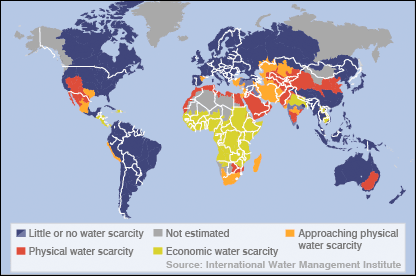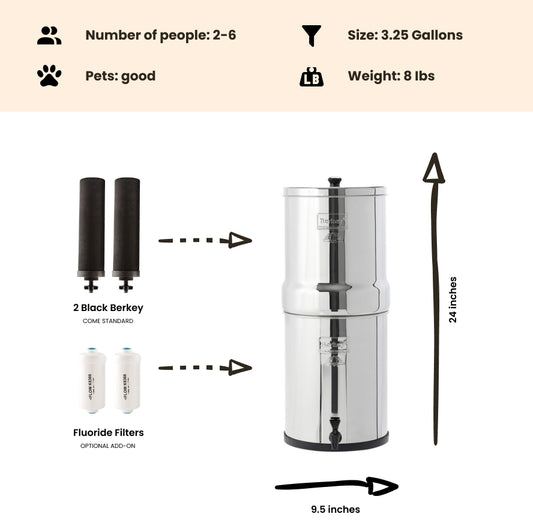
Climate Change Increases Global Water Scarcity Risk
By Dan DeBaunShare
People living in many regions around the world are currently feeling the impact of water scarcity. As populations continue to grow in the future, so too will the pressure on freshwater resources increase further still. However, in stark contrast to this, water supply is projected to undergo some drastic changes due to a shift in rainfall patterns and evaporation. Scientists estimate that 40% more people – who would otherwise be unaffected if climate change was not a factor – are now in danger of experiencing absolute water scarcity due to climate change. The results of the study which models a wide range of impacts was published online in a special edition of the Proceedings of the National Academy of Sciences focused on presenting initial results from the Inter-Sectoral Impact Model Intercomparison Project (ISI-MIP), an unparallelled community-driven project that brings research on issues related to climate change to a whole new level.
“The steepest increase of global water scarcity might happen between 2 and 3 degrees global warming above pre-industrial levels, and this is something to be experienced within the next few decades unless emissions get cut soon,” says lead-author Jacob Schewe of the Potsdam Institute for Climate Impact Research. “It is well-known that water scarcity increases, but our study is the first to quantify the relative share that climate change has in that, compared to – and adding to – the increase that is simply due to population growth.”
Water Availability Will Vary Greatly from Region to Region
It is estimated that between 1-2% of the global population live in regions that currently face absolute water scarcity. Climate change together with population growth would cause this figure to rise to approximately 10% should temperatures rise by 3 degrees Celsius. The researchers define absolute water scarcity as <500 m3 of water available per person per year – at these low levels super efficient water management and water use methods need to be applied in order for the supply to be adequate. By comparison, globally the average annual water consumption per capita equates to approximately 1200 m3, and is typically substantially higher than this in many developed countries around the world.
Because the effects of climate change differ in different regions of the world, there are likely to be substantially large differences on the impact of climate change in terms of water availability experienced in different regions of the world. While certain regions, such as the Middle East, Mediterranean, southern China, and southern USA are likely to experience a marked decrease in water availability, other areas, such as western China, Southern India, and certain areas in Eastern Africa may experience a substantial increase in water availability.
Water Security Vital for Food Security
With agriculture being one of the biggest consumers of water globally, it goes without saying that water security is essential for food security for many nations around the world – a scarcity of either can threaten human development. However, an increase in rainfall can also be a challenge as surplus water can result in waterlogged soils, flooding, and can cause water-related infrastructure to malfunction or fail. Furthermore, many industries utilize vast quantities of waterduring various production processes, consequently water shortages could hamper economic development in regions where it is scarce.
This research is a collaborative effort between various international researchers who used 11 global hydrological computer models combined with 5 global climate computer models to simulate various scenarios in terms of how climate change will affect water scarcity. The combined ISI-MIP procedure systematically analyzes the results produced by the different computer generated simulations to determine where there are similarities and where there are not. The data presented here represent the average of the multi-model results – certain models showed even more drastic decreases in water availability.
Unparalleled Multi-model Approach Provides Risk-management Perspective
“The multi-model assessment is unique in that it gives us a good measure of uncertainties in future impacts of climate change – which in turn allows us to understand which findings are most robust,” says co-author Pavel Kabat of the International Institute for Applied Systems Analysis (IIASA). “From a risk management perspective, it becomes very clear that, if human-made climate change continues, we are putting at risk the very basis of life for millions of people, even according to the more optimistic scenarios and models.”
He stressed that the work is not over, and that there is still a need for further research focusing on future water requirements of various sectors such as agriculture, energy and industry, as well as how new technology together with a reduction in greenhouse-gas emissions can improve water availability.
Journal Reference:
Schewe, J., et al. (2013): Multi-model assessment of water scarcity under climate change. Proceedings of the National Academy of Sciences (early online edition); DOI:10.1073/pnas.1222460110
-
Regular price $234.00 USDRegular priceUnit price / per
-
Regular price $327.00 USDRegular priceUnit price / per
-
Regular price From $367.00 USDRegular priceUnit price / per
-
Regular price From $408.00 USDRegular priceUnit price / per
-
Regular price From $451.00 USDRegular priceUnit price / per
-
Regular price From $478.00 USDRegular priceUnit price / per
-
Regular price $332.50 USDRegular priceUnit price / per
$350.00 USDSale price $332.50 USDSale

Dan DeBaun
Dan DeBaun is the owner and operator of Big Berkey Water Filters. Prior to Berkey, Dan was an asset manager for a major telecommunications company. He graduated from Rutgers with an undergraduate degree in industrial engineering, followed by an MBA in finance from Rutgers as well. Dan enjoys biohacking, exercising, meditation, beach life, and spending time with family and friends.
~ The Owner of Big Berkey Water Filters
















